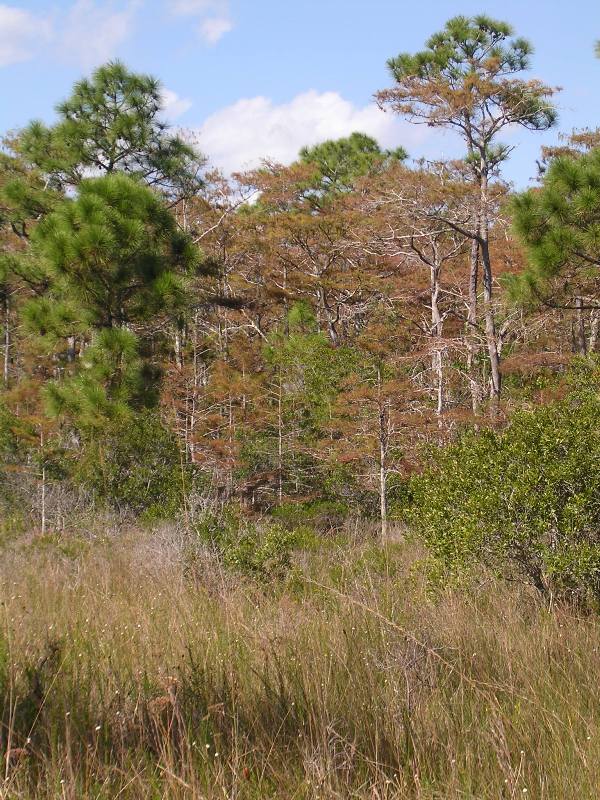
Pond Cypress
Taxodium ascendens
Pond Cypress is found from Virginia to Miami Dade County. It is similar to the Bald Cypress and may even occur with it. The leaflets of Pond Cypress tend to circle the midrib, especially the upper ones, while the leaflets of Bald Cypress are flat like a feather and are softer than Pond Cypress.
Pond Cypress has branches that are less muscular than Bald and it can grow in less fertile soil. You will often find it mixed with Slash Pine in Florida where the soil is moist yet not very fertile. It also makes up cypress domes, like the ones you see in Everglades Park. Bald Cypress likes rich soil along sloughs, rivers and lakes, like lake Okeechobee.
The leaves of both drop in the fall leaving a stark landscape during winter, yet put on soft, light green leaves in the spring. During the stark times, air plants, orchids, ferns, and other shade tolerant plants grow and store energy for the rest of the year.
The wind pollinated flowers are in racemes (catkins) with male and female found separately on each tree. These are followed by a one inch round ball that contains angular seeds coated in hard resin. The seed will only germinate in moist soil where the seedling can grow tall enough to rise above floodwaters that would drown it during the summer rains.
Some wildlife will feed on the seeds including wood ducks and squirrels, yet they aren’t a great source of wildlife food the way oaks are. What this tree does provide are branches for epiphytes to grow on and roosts for many wading birds. These birds also build nests there if a Pond Cypress is growing out in the water where raccoons can’t swim to it.
Pond Apple is another good nesting tree that can be planted out in the water of a lake or pond. You can plant a six foot tall tree of either directly in water; it is just the seedling that will drown if covered during flooding season.
Pond Cypress will grow to 20 feet in 10 years if planted in average, moist soil. It will reach 100 or more feet in good soil, yet only your great, great grandchildren will have to worry about it falling on them as we know all tall trees are prone to do. By the way, how often do you read of a tree falling on someone and killing them compared with someone being injured by slipping in a shower?
This is a great tree to completely change the texture of the landscape. As you can see in the picture, the fine brown leaves of fall and the bonsai like branches mixed with dark green Slash Pine and wetland species make one of the most interesting pictures I have.
If you are lucky to have a low wet area of the yard that most likely had cypress in it before development just replant it with an oddly spaced forest of Pond Cypress, Red Maple, Sweetbay Magnolia, Swamp Redbay, Buttonbush, Virginia Willow, Leather Fern. Duck Potato, Thalia, Prairie Iris, Yellow Canna, Swamp and Marsh Ferns and other wetland species. Why fill the depression and grow sod?